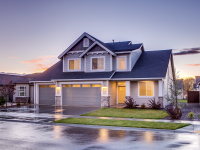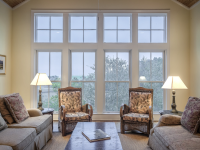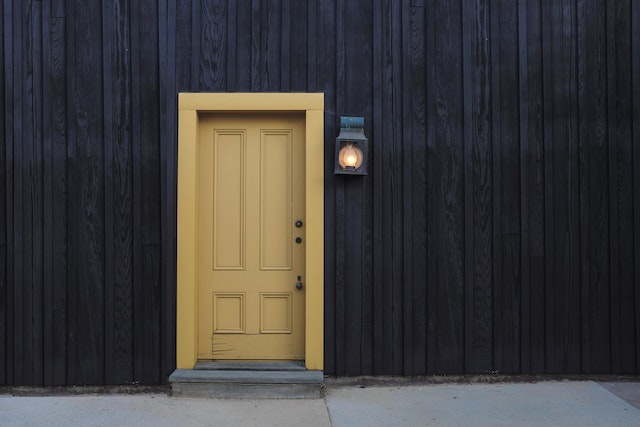When it comes to upgrading your home’s exterior, few decisions have as much impact as selecting the right door. Whether you’re considering sliding patio door replacement, or entry and front door replacement, the choice of door material is crucial. With a plethora of options available, such as wood, fiberglass, and steel, it can be overwhelming to determine which material will best suit your needs. In this comprehensive guide, we will dive into the advantages of each material, comparing their appearance, cost, durability, energy efficiency, security, maintenance, sound insulation, and environmental impact.
So, let’s embark on a journey to find the perfect door material that will not only enhance the aesthetic appeal of your home but also provide long-lasting performance and security.
Wood vs. Fiberglass vs. Steel Doors and The Advantages of Each
Let’s begin by highlighting the advantages of each material for sliding patio door replacement, or entry and front door replacement.
Appearance
The appearance of your entry and front door replacement plays a significant role in enhancing your home’s curb appeal. Wood doors are known for their classic, natural appearance and the ability to be easily customized. They offer a traditional charm that many homeowners appreciate. On the other hand, steel doors are considered the least adaptable in terms of appearance. They often feature a smooth surface and less defined panel embossments, which may result in a lower curb appeal compared to wood and fiberglass doors. Fiberglass doors, however, provide a good compromise between wood and steel. They have evolved to mimic the look of wood graining and come in various styles with well-defined panel embossments. Additionally, fiberglass doors can be stained or painted based on your preference or architectural style.
Cost
Price is a crucial factor when selecting a door material. Wood doors generally have a moderate to high cost, especially if you opt for high-quality wood. The price can vary depending on the type of wood and slab sizes. Basic steel doors, on the other hand, are relatively low-cost compared to wood and fiberglass. However, severe weather conditions can lead to dents and rust, which might require a full door replacement. Fiberglass doors fall into the higher price range, but their high performance and durability make them a worthwhile investment. They can last for decades with minimal maintenance.
Durability
Durability is a key consideration when choosing an exterior door. Wood doors, while visually appealing, are susceptible to weather damage, scratches, dents, warping, and moisture damage. They typically last an average of 10-30 years, depending on various factors. Steel doors are more durable than wood and fiberglass initially, but they are more prone to dents, scratches, and rust in the long term. If not properly maintained, steel doors may require a complete replacement. On the other hand, fiberglass doors are designed with durability in mind. They are resistant to warping, rotting, and cosmetic damage. Fiberglass doors can last 50 years or more with minimal chipping or denting, making them a long-lasting option.
Energy Efficiency
Energy efficiency is an essential factor to consider to reduce heating and cooling costs in your home. Wood doors have relatively poor insulation compared to steel and fiberglass. Natural wood is more likely to disperse heat from indoors to outdoors and vice versa. Steel doors, when made properly with a good thermal break and high-density polyurethane foam, can be more energy-efficient than wood. However, steel is a strong temperature conductor, which means it can be affected by the weather. Fiberglass doors, with high-quality foam cores tightly packed, offer excellent insulation and help maintain a consistent temperature. They are top-rated in terms of energy efficiency and can lower your energy bills in any season.
Security
Security is a significant concern for homeowners when selecting a sliding patio door replacement or entry and front door replacement door. Wood doors’ resistance to breaking under tension depends on the quality and type of wood. Softer woods are less secure and more likely to break under impact. Steel doors are dense and difficult to force open, but their strength can vary. Some steel doors sold by larger retailers are made from lower-strength steel, while select manufacturers offer stronger steel options. Fiberglass doors, with their thicker skin and rigid foam core, provide enhanced security. They are resistant to forced entry and often feature extended lockblocks that reinforce the door’s structural rigidity. Additionally, composite door frames used with fiberglass doors are more durable and rigid than wood frames, further improving security.
Maintenance
Maintenance requirements are another important consideration when choosing a door material. Wood doors typically require periodic painting or staining to maintain their appearance and protect them from the elements. Without proper maintenance, wood doors can warp, crack, or rot over time. Additionally, they may need refinishing every few years to keep them looking their best. On the other hand, fiberglass doors are virtually maintenance-free. They are resistant to warping, cracking, and rotting, and their finish typically lasts for many years. However, fiberglass doors can be ruined if scratched or dented, requiring a full replacement. Steel doors also require minimal maintenance. They are resistant to warping and cracking, and their smooth surface is easy to clean. However, like wood doors, they may need periodic painting or touch-ups if scratched or dented to prevent rust.
Sound Insulation
If noise reduction is a concern in your home, the sound insulation properties of the door material should be considered. Wood doors provide good sound insulation due to their solid construction and density. They can help reduce the transmission of outdoor noise, creating a quieter indoor environment. Fiberglass doors, with their foam cores and thick skins, also offer good sound insulation. They can effectively block noise from outside, making them suitable for homes located near busy streets or in noisy neighborhoods. Steel doors, while generally durable and secure, may have lower sound insulation properties. Without proper insulation or foam cores, steel can transmit sound more easily than wood or fiberglass.
Environmental Impact
Considering the environmental impact of the door material is important for eco-conscious homeowners. Wood doors can be sustainable if sourced from responsibly managed forests or certified suppliers. Opting for doors made from reclaimed or recycled wood can further reduce environmental impact. It’s essential to choose wood that has been harvested following sustainable practices to ensure the long-term health of forests. Fiberglass doors can be eco-friendly if they are manufactured using recycled materials. Some manufacturers offer fiberglass doors with recycled glass content, reducing the need for virgin materials. Additionally, fiberglass doors’ long lifespan and energy efficiency contribute to their overall environmental friendliness. Steel doors, while recyclable, have a higher embodied energy due to the manufacturing process. However, recycling steel can help reduce waste and conserve resources.
Customization Options
Customization options allow homeowners to tailor their doors to their specific preferences and architectural styles. Wood doors are highly customizable, allowing for intricate designs, carving, and decorative elements. They can be easily stained or painted to achieve the desired color and finish. Fiberglass doors have evolved to offer a range of customization options as well. They can mimic the look of wood graining, providing a classic aesthetic, or have a more modern appearance with sleek lines and contemporary finishes. Fiberglass doors can also be stained or painted to match the desired style. Steel doors, while less versatile in terms of customization, come in various panel designs and finishes, including textured or smooth surfaces. Some manufacturers offer steel doors with decorative glass inserts to add visual interest.
Conclusion
In conclusion, choosing the right sliding patio door replacement or entry and front door replacement material involves considering several factors, including appearance, cost, durability, energy efficiency, security, maintenance, sound insulation, and environmental impact. Wood doors offer a classic, natural appearance but require periodic maintenance.
Fiberglass doors provide a balance between aesthetics and durability, with the ability to mimic wood and offer excellent energy efficiency. Steel doors are low-maintenance and highly secure but may require touch-ups if scratched or dented.
By carefully evaluating your priorities and weighing the pros and cons of each material, you can select the ideal door material for your home. Whether you prioritize aesthetics, durability, energy efficiency, or security, there is a suitable option available to enhance your home’s entryway. Remember to consult with local suppliers or residential door replacement companies to explore the specific door options and costs available in your area.


















